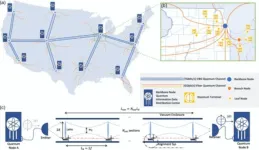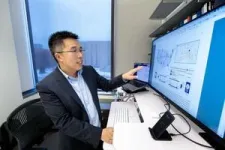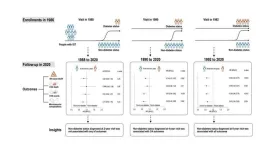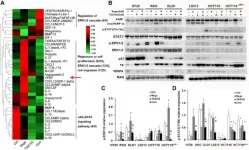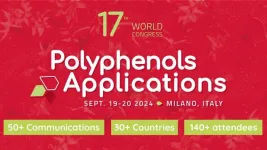(Press-News.org) Quantum computers offer powerful ways to improve cybersecurity, communications, and data processing, among other fields. To realize these full benefits, however, multiple quantum computers need to be connected to build quantum networks or a quantum internet. Scientists have struggled to come up with practical methods of building such networks, which must transmit quantum information over long distances.
Now, researchers at the University of Chicago Pritzker School of Molecular Engineering (PME) have proposed a new approach — building long quantum channels using vacuum sealed tubes with an array of spaced-out lenses. These vacuum beam guides, about 20 centimeters in diameter, would have ranges of thousands of kilometers and capacities of more than 1013 qubits per second, better than any existing quantum communication approach. Photons of light encoding quantum data would move through the vacuum tubes and remain focused thanks to the lenses.
“We believe this kind of network is feasible and has a lot of potential,” said Liang Jiang, professor of molecular engineering and senior author of the new work. “It could not only be used for secure communication, but also for building distributed quantum computing networks, distributed quantum sensing technologies, new kinds of telescopes, and synchronized clocks.”
Jiang collaborated with scientists at Stanford University and the California Institute of Technology on the new work, which is published in Physical Review Letters.
Sending qubits
While classical computers encode data in conventional bits — represented as a 0 or 1 — quantum computers rely on qubits, which can exhibit quantum phenomena. These phenomena include superposition — a kind of ambiguous combination of states — as well as entanglement, which allows two quantum particles to be correlated with each other even across vast distances.
These properties give quantum computers the ability to analyze new types of data and store and pass along information in new, secure ways. Connecting multiple quantum computers can them even more powerful, as their data processing abilities can be pooled. However, networks typically used to connect computers are not ideal because they cannot maintain the quantum properties of qubits.
“You can’t send a quantum state over a classical network,” explained Jiang. “You might send a piece of data classically, a quantum computer can process it, but the result is then sent back classically again.”
Some researchers have tested ways of using fiber-optic cables and satellites to transmit optical photons, which can act as qubits. Photons can travel a short distance through existing fiber-optic cables but generally lose their information quickly as photons are absorbed. Photons bounced to satellites and back to the ground in a new location are absorbed less because of the vacuum of space, but their transmission is limited by the atmosphere absorption and availability of the satellites.
“What we wanted to do was to combine the advantages of each of those previous approaches,” said PME graduate student Yuexun Huang, the first author of the new work. “In a vacuum, you can send a lot of information without attenuation. But being able to do that on the ground would be ideal.”
Learning from LIGO
Scientists working at the Laser Interferometer Gravitational-Wave Observatory (LIGO) the California Institute of Technology have built huge ground-based vacuum tubes to contain moving photons of light that can detect gravitational waves. Experiments at LIGO have shown that inside a nearly-molecule-free vacuum, photons can travel for thousands of kilometers.
Inspired by this technology, Jiang, Huang, and their colleagues began to sketch out how smaller vacuum tubes could be used to transport photons between quantum computers. In their new theoretical work, they showed that these tubes, if designed and arranged properly, could carry photons across the country. Moreover, they would only need medium vacuum (10^-4 atmosphere pressure), which is much easier to maintain than the ultra-high vacuum (10^-11 atmosphere pressure) required for LIGO.
“The main challenge is that as a photon moves through a vacuum, it spreads out a bit,” explained Jiang. “To overcome that, we propose putting lenses every few kilometers that can focus the beam over long distances without diffraction loss.”
In collaboration with researchers at Caltech, the group is planning tabletop experiments to test the practicality of the idea, and then plans to use larger vacuum tubes such as those at LIGO to work on how to align the lenses and stabilize the photon beams over long distances.
“To implement this technology on a larger scale certain poses some civil engineering challenges that we need to figure out as well,” said Jiang. “But the ultimate benefit is that we have large quantum networks that can communicate tens of terabytes of data per second.”
Citation: “Vacuum Beam Guide for Large Scale Quantum Networks,” Huang et al, Physical Review Letters, July 9, 2024. DOI: 10.1103/PhysRevLett.133.020801
Funding: This work was supported by the Army Research Laboratory, Air Force Research Laboratory, National Science Foundation, NTT Research, Packard Foundation, the Marshall and Arlene Bennett Family Research Program, and the U.S. Department of Energy.
END
New method could yield fast, cross-country quantum network
PME researchers outlined a new method to build a quantum network that spans the country by using vacuum beam guides, in which qubits can travel thousands of miles inside small vacuum-sealed tubes.
2024-07-09
ELSE PRESS RELEASES FROM THIS DATE:
Aging retinal pigmented epithelium: Omics-based insights into vision decline
2024-07-09
“These findings potentially support employing anti-aging therapies such as senolytic pharmacologic compounds to prevent or ameliorate progression to AMD [...]”
BUFFALO, NY- July 9, 2024 – A new editorial paper was published in Aging (listed by MEDLINE/PubMed as "Aging (Albany NY)" and "Aging-US" by Web of Science) Volume 16, Issue 12, entitled, “Aging retinal pigmented epithelium: omics-based insights into vision decline.”
In this new editorial, researchers Ioan V. Matei and Luminita Paraoan from ...
Public health researchers detail way forward post-pandemic
2024-07-09
AURORA, Colo. (July 9, 2024) – In the aftermath of the COVID-19 pandemic, the U.S. public health system must focus on critical questions of accountability, politicization and updating data systems if it is to do its job well and maintain the trust of the American people, according to a new report from the Colorado School of Public Health.
The report, authored by Professor Jonathan Samet, MD, MS, of the Colorado School of Public Health and Professor Ross Brownson, PhD, of Washington University in St. Louis, was published recently in the journal Health Affairs.
In ...
Improving 'health span' through slowing age-related cognitive decline
2024-07-09
Two University of Oklahoma researchers have been awarded more than $2 million in grants from the Hevolution Foundation to further their studies on age-related cognitive impairment, with an emphasis on improving “health span,” or the number of years a person remains healthy.
While modern medicine can help extend a person’s life span, researchers are increasingly studying ways to increase their healthy years of life. Because the process of aging increases the risk for memory problems and dementia, researchers must understand why as a first step toward delaying cognitive issues until later in life. The Hevolution Foundation ...
Globally significant upwelling is driven by topographical features on seafloor
2024-07-09
Irvine, Calif., July 9, 2024 – Exactly how the turbulent mixing of ocean water relates to global overturning circulation has been little understood by oceanographers, but an international research team, including an Earth system scientist at the University of California, Irvine, has found that bumpy topographical features along the sloping ocean floor contribute significantly to ocean seawater upwelling.
In a paper published recently in Nature, the researchers describe a “vigorous near-bottom upwelling” that results in the upward transition of water from denser to lighter ocean layers at a rate ...
Dolls and trucks: Political right and left share some parenting beliefs
2024-07-09
Key takeaways
Virtually all study respondents on the political left and more than 75% on the right supported allowing children to play with both traditionally “girl” and “boy” toys.
Those on both sides of the political spectrum also supported the idea that girls should be able to aspire to traditionally male pursuits.
However, while most left-wing activists supported the idea of a child living in a way that does not align with their birth sex, most right-wing activists rejected the idea.
Society appears deeply divided on how to parent with regard to gender.
For example, some parents throw “gender reveal” ...
Delaying diabetes with diet and exercise for 4 years results in better long-term health
2024-07-09
Individuals diagnosed with prediabetes can reduce their long-term risk of death and diabetes-related health complications if they delay the onset of diabetes for just four years through diet and exercise. Guangwei Li of the China-Japan Friendship Hospital and colleagues report these findings in a new study published July 9th in the open-access journal PLOS Medicine.
Type 2 diabetes is associated with an increased risk of death and disability, and imposes a significant economic burden on individuals and societies worldwide. Lifestyle changes, such as eating a healthy diet and getting more exercise, can delay or reduce the risk of developing diabetes in people ...
Global database reveals large gaps in our knowledge of four-footed animals
2024-07-09
Researchers developed TetrapodTraits – a global database of animals with four feet – which can now be applied for better ecology, evolution and conservation research. Mario Moura of the Universidade Estadual de Campinas, Brazil, and Walter Jetz of Yale University, US, published this work on July 9th in the open-access journal PLOS Biology.
Tetrapods, which include amphibians, reptiles, birds and mammals, are generally well-documented species, which makes them useful as models in global biodiversity studies. However, gaps in our knowledge about many of these species, data inconsistencies and shifting scientific names can lead to biased conclusions about biodiversity. To help ...
Regorafenib synergizes with TAS102 against multiple gastrointestinal cancers
2024-07-09
“In this study, we investigated the therapeutic effects and the underlying mechanisms of TAS-102 in combination with regorafenib against gastrointestinal cancers.”
BUFFALO, NY- July 9, 2024 – A new research paper was published in Oncotarget's Volume 15 on July 2, 2024, entitled, “Regorafenib synergizes with TAS102 against multiple gastrointestinal cancers and overcomes cancer stemness, trifluridine-induced angiogenesis, ERK1/2 and STAT3 signaling regardless of KRAS or BRAF mutational status.”
Single-agent TAS102 (trifluridine/tipiracil) and regorafenib ...
Stem cell-derived therapy shows promise against treatment-resistant liver cancer
2024-07-09
Researchers at University of California San Diego have found that the most common form of liver cancer — one with a high mortality rate — can be better targeted and treated using an innovative new stem cell-derived therapy, according to a recently published study in Cell Stem Cell.
The treatment, not yet studied in patients, involves the lab engineering of natural killer (NK) cells — white blood cells that destroy tumor cells — to more effectively battle hepatocellular carcinoma (HCC), one of the most treatment-resistant types of solid tumor.
Genetically modified NK-cell therapy doesn't require ...
Innovations in polyphenols research: Highlights from the upcoming 17th Annual 2024 World Congress in Milan
2024-07-09
The 17th World Congress on Polyphenols Applications, taking place on September 19-20, 2024, at Università degli Studi di Milano Statale in Milan, Italy, will gather more than 140 attendees coming from 30+ countries. More than 20 international speakers will cover the latest advances in polyphenols research and their practical applications.
Key Topics
Polyphenols Applications 2024 will cover a wide range of topics, including the challenges in demonstrating the health benefits of polyphenols, the ...
LAST 30 PRESS RELEASES:
American Meteorological Society announces Rick Spinrad as 2026 President-Elect
Biomass-based carbon capture spotlighted in newly released global climate webinar recording
Illuminating invisible nano pollutants: advanced bioimaging tracks the full journey of emerging nanoscale contaminants in living systems
How does age affect recovery from spinal cord injury?
Novel AI tool offers prognosis for patients with head and neck cancer
Fathers’ microplastic exposure tied to their children’s metabolic problems
Research validates laboratory model for studying high-grade serous ovarian cancer
SIR 2026 delivers transformative breakthroughs in minimally invasive medicine to improve patient care
Stem Cell Reports most downloaded papers of 2025 highlight the breadth and impact of stem cell research
Oxford-led study estimates NHS spends around 3% of its primary and secondary care budget on the health impacts of heat and cold in England
A researcher’s long quest leads to a smart composite breakthrough
Urban wild bees act as “microbial sensors” of city health.
New study finds where you live affects recovery after a hip fracture
Forecasting the impact of fully automated vehicle adoption on US road traffic injuries
Alcohol-related hospitalizations from 2016 to 2022
Semaglutide and hospitalizations in patients with obesity and established cardiovascular disease
Researchers ‘listen in’ to embryo-mother interactions during implantation using a culture system replicating the womb lining
How changing your diet could help save the world
How to make AI truly scalable and reliable for real-time traffic assignment?
Beyond fragmented markets: A new framework for efficient and stable ride-pooling
Can shape priors make road perception more reliable for autonomous driving?
AI tracks nearly 100 years of aging research, revealing key trends and gaps
Innovative techniques enable Italy’s first imaging of individual trapped atoms
KIER successfully develops Korea-made “calibration thermoelectric module” for measuring thermoelectric device performance
Diversifying US Midwest farming for stability and resilience
Emphasizing immigrants’ deservingness shifts attitudes
Japanese eels, climate change, and river temperature
Pusan National University researchers discover faster, smarter heat treatment for lightweight magnesium metals
China’s 2024 Gastroenterology Report: marked progress in endoscopy quality and disease management
Pusan National University researchers uncover scalable method for ultrahigh-resolution quantum dot displays
[Press-News.org] New method could yield fast, cross-country quantum networkPME researchers outlined a new method to build a quantum network that spans the country by using vacuum beam guides, in which qubits can travel thousands of miles inside small vacuum-sealed tubes.
